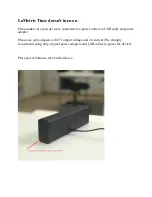
Analog Clock install requirements
• Refer to the Important Safety Instructions before installing, operating, or performing clock maintenance.
• Before installing a clock, verify the main Transmitter is operating properly and transmitting a signal with adequate
building coverage. The transmit (broadcast) schedule varies by Transmitter model.
• Clocks must be installed at a location within adequate transmission range of the Transmitter.
• Sites with more than one Transmitter, it's very important to only insert a clock's batteries at its permanent install
location.
• Any damage to the clock due to improper wiring voids the warranty. It is at Primex discretion as to whether damage
to the clock was caused by improper wiring.
Clock signal search schedule (when a clock receives a time update)
When a clock is first powered on, it automatically initializes its setup and searches for a signal from a Transmitter to
receive its time.
• After a clock is powered on it then searches for a signal at six pre-scheduled times a day, at 2:01 AM/PM, 6:01
AM/PM, and 10:01 AM/PM clock time (not the actual time of the day), a clock's receiver turns on to search for a
Transmitter signal to receive a time update, starting with the previously stored channel number. If a signal is not
received from the first channel, the clock scans all channels to search for a signal.
• To manually reset a clock after installation, simply remove its power source for at least 10 seconds and then reapply
its power source. The clock automatically searches for a signal and resets its time when it receives a signal.
• When a clock has not received a valid signal/time update for three consecutive days, it displays a visual signal loss
indicator; an analog clock's second-hand advances and pauses continuously (stepping) and a digital clock/timer's
colons flash. A clock may display the correct time, but it's not synchronized and its time may drift.
Transmitter schedule (when a transmitter transmits a time update)
The type of antenna determines when a Transmitter transmits synchronized time updates, which should be taken into
consideration when installing new devices. Devices receive a time update during their scheduled signal search or when
powered on.
Transmitter with an internal antenna
Transmitter with Internal Antenna: transmits (broadcasts) synchronized time continuously to the system clocks and
devices.
Transmitter with an external antenna
Transmitter with an external antenna: transmits (broadcasts) synchronized time to the system clocks and devices
from the 39th to the 6th minute of the next hour and changes to a standby mode during the 7th to the 38th minute of
the hour (standard broadcast schedule). During initial power-up, the Transmitter transmits a signal for 8 consecutive
hours. After the 8 hour power-up period, the Transmitter reverts to its timed transmit schedule. Power-cycling a
Transmitter will set it into an 8 hour continuous transmit schedule.
Page 4





































